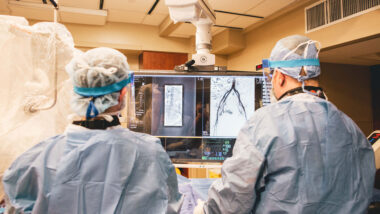Peripheral artery disease (PAD) is a common circulatory disease, but you’ve probably never heard of it. In the United States, PAD affects more than 6.5 million people 40 years old and older, both men and women. This condition can significantly impact overall health, mobility, and quality of life, and if left untreated, can lead to amputation of limbs. With treatment, these outcomes can be managed for millions of patients living with this chronic disease.
What is PAD exactly? It’s a condition where the blood flow to the legs is blocked due to the build-up of plaque in the walls of the arteries. This can cause pain, cramping, weakness, and in severe cases, foot pain, ulcers, and non-healing wounds. Thanks to the advancement of modern medicine, surgery is no longer the only solution. As an alternative, there are minimally invasive procedures through interventional radiology which use image guidance to diagnose and treat this condition and ultimately help preserve both life and limb.
What Robert Discovered About His Non-Healing Wounds
Charlotte Radiology patient Robert shares his experience with PAD and how it all started with small cuts on his foot that got infected. Robert knew there was something wrong because the cuts would never fully heal. He later learned that this was due to plaque clogging the arteries in his leg. Watch the full video to learn more about his story.
PAD Symptoms
While some people with peripheral artery disease may have only mild or no symptoms, most who suffer from PAD experience some combination of the following symptoms:
- Muscular pain with physical activity, but relief after rest
- Prolonged soreness of feet, legs, and/or toes
- Impaired wound healing
- Discoloration of legs
- Ulcers
- Hair loss
- Muscle atrophy
- Smooth shiny skin
Many suffering from PAD may dismiss leg pain, or other symptoms as a normal part of aging, but it’s important to take note of these changes to your body. Be your own health advocate and consult your concerns with your primary care physician. PAD can be diagnosed with an ultrasound exam or an Ankle-Brachial Index (ABI) test which examines the blood pressure at the ankle to the blood pressure in the upper arm.
Risk Factors for PAD
While there are certain risk factors for PAD that can be managed by living a healthy lifestyle, there are others that cannot. If you have any risk factors for PAD, it’s important to talk to your doctor and get screened even if you’re not experiencing any symptoms.
Factors that increase your risk for PAD include:
- Aging (typically occurs in people over the age of 50)
- Smoking
- Diabetes
- High blood pressure or high cholesterol
- Chronic kidney disease or those on dialysis
Preventative Care Treatments for PAD
There are many benefits of living a healthy lifestyle and making wellness checks a priority, but did you know that these measures can also help keep your PAD in check? In cases where PAD isn’t severe, it can be treated with preventative care through lifestyle changes or medication.
Lifestyle Changes
To stop the progression of PAD, lifestyle changes may be recommended by your primary care physician including:
- Regular physical activity
- A diet low in saturated and trans fat to help lower blood cholesterol levels
- Taking steps to quit smoking
Medication
It’s important to take any medication that your physician prescribes as it can reduce your risk for PAD, as well as heart attack and stroke. Medications that may be prescribed include:
- Aspirin and/or clopidogrel to prevent blood clots
- Cholesterol-lowering medications
- High blood pressure medications
- Blood sugar control medications
Minimally Invasive PAD Treatment Options
If your PAD is more severe and cannot be treated with lifestyle changes and/or medication, a minimally invasive procedure may be the solution. The Vascular & Interventional Specialists at Charlotte Radiology will partner with you and your doctor on a personalized treatment plan to ensure the best possible outcomes. With interventional radiology, the treatment is often fast, effective, and doesn’t require a hospital stay.
- Balloon angioplasty – used to treat vascular blockage(s) to improve blood flow. Under X-ray guidance, an interventional radiologist will inflate and deflate a small balloon across the blocked artery to stretch or mold the artery open
- Atherectomy – a minimally invasive device that uses a small blade to remove plaque in the arteries
- Stent placement – a stent (metal device) may be placed the keep the artery open
We encourage you to stay in tune with your body and not ignore the typical signs of aging. As we grow older and the body continues to change, it’s important to speak with your primary care doctor with any health questions or concerns. What Robert thought was poor circulation turned out to be something more serious and he is glad he sought out the care he needed.
If you think you have PAD or would like to learn more, schedule a consultation.
Sources:
-
- https://www.mayoclinic.org/tests-procedures/ankle-brachial-index/about/pac-20392934″>https://www.mayoclinic.org/tests-procedures/ankle-brachial-index/about/pac-20392934
- International Diabetes Federation and International Working Group of the Diabetic Foot In: Time to act. Bakker K, Foster AVM, van Houtoum WH, Riley P, editors; The Netherlands: 2005. Vasc Endovascular Surg. 2014 Feb;48(2):129-33 2012;125:130–139 2005 Dec 3;366(9501):1925-34 Vascular Health and Risk Management 2020:16 57–66
- https://www.mayoclinic.org/diseases-conditions/peripheral-artery-disease/diagnosis-treatment/drc-20350563″>https://www.mayoclinic.org/diseases-conditions/peripheral-artery-disease/diagnosis-treatment/drc-20350563
- https://www.heart.org/en/health-topics/peripheral-artery-disease/prevention-and-treatment-of-pad#:~:text=Smoking%20Cessation&text=If%20you%20smoke%2C%20take%20steps,and%20other%20heart%2Drelated%20diseases”>https://www.heart.org/en/health-topics/peripheral-artery-disease/prevention-and-treatment-of-pad#:~:text=Smoking%20Cessation&text=If%20you%20smoke%2C%20take%20steps,and%20other%20heart%2Drelated%20diseases



